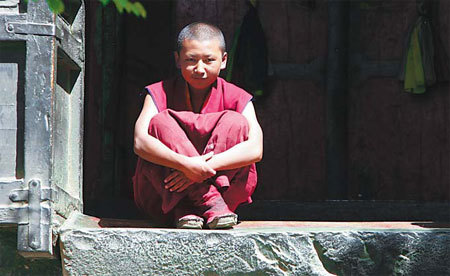For Losang Zaxi, a 20-year-old lama in the Tashilhunpo Monastery of Xigaze in Tibet, life is not all that different from that of his peers.
Every day, he spends his spare time watching TV and Jet Li's kung fu movies, listening to pop music and sending text message to his friends on his mobile phone.
|

|
|
Many lamas in Tashilhunpo Monastery, Xigaze, can speak English, use computers and are familiar with modern technology. |
The quiet boy, a native of Xigaze, studied at a village primary school. He didn't want to study further, so he became a lama.
"Being a lama was more difficult than school, because there were so many rules to follow in the monastery," he says.
For instance, Internet cafes are strictly off-limits to monks of the Tashilhunpo Monastery. "There are too many temptations on the Internet. Once a monk is addicted, his study of Buddhism will suffer," says Losang Yignyen, 30, an assistant to Salung Phunlha, deputy chief of the monastery.
According to Salung, the 600-year-old monastery now houses more than 800 lamas, with fewer than 300 young men like Losang. In the 1950s, there were nearly 5,000 lamas in the monastery.
"They fell into three categories: pious believers, children of poor serfs who entered the monastery to make a living and those sent to the temples to meet a quota," he says.
Temples had quotas for the serfs, and those who joined for this reason were called zunzhas. More than 70 percent of the lamas were from impoverished families, he says.
Monasteries, along with aristocrats and government officials, were among the landowners in Tibet at that time. Farmers worked the land under contract and had to turn in grain, butter and fodder as tax. Hence, each lama at the temple could get 42 kg of food per month without doing any of the work it took to produce the food, says Qiangba, 64, a former lama in Tashilhunpo.
After democratic reform in 1959, the manors and land were confiscated. Some 3,000 lamas left for a secular life.
The question then arose: how could the remaining lamas survive?
They had to work and this meant only four days a week could be devoted to Buddhist ceremonies, Qiangba recalls.
In the 1980s, the 10th Panchen Lama proposed that the monastery develop its own businesses to support itself. He bought some dairy cows from the Xinjiang Uygur autonomous region and asked Qiangba, who had attended agricultural school in 1976, to work as a technician.
The farm was established in 1986 and by 2008, it had more than 60 dairy cows and some 34 hectares of land growing grain and watermelon.
The Tashilhunpo Monastery also owned several companies, grouped under the Gangjian group, whose businesses ranged from tourism to making furniture, carpets and Thangka, or paintings with religious themes. With more than 500 employees, the company had annual revenues of 1 million yuan ($146,000) at its prime. In 2006, it invested 40 million yuan - some of it borrowed - to build a four-story hotel in Lhasa. But the hotel was torched by rioters last March.
The Tashilhunpo Monastery is not the only one to see a sharp decrease in the ranks of its lamas in the past 50 years. This has happened at many monasteries housing one of the four sects of Tibetan Buddhism.
The Drepung Monastery has nearly 500 lamas, but the population before 1959 was 7,700.
"In the past, education was a privilege reserved for the aristocrats and ordinary people had to study in temples if they didn't want to be illiterate," says Ngawang Chozin, deputy chief of the Drepung Monastery. "But now, everyone can attend school."
Development also brought temptation. "Each year, about 10 lamas left to return to secular life," says Salung. A few were expelled for breaking the rules.
However, Drigung Qongtsam Losang Champa, vice-chairman of the Tibet branch of the Buddhist Association of China, says he does not see the decreased numbers as such a bad thing.
"In the past, although there were more lamas, they were definitely not more knowledgeable than the current ones," he says, adding that now many Tibetan lamas can speak English, use computers and are familiar with science and technology.
Currently, Tibet boasts more than 1,700 monasteries, which accommodate 46,000 lamas and nuns, accounting for 2 percent of Tibet's population. But most of the nearly 3 million people in the region are active Buddhists, who worship and conduct rituals at home, notes Drigung.
Every day hundreds, or even thousands, of pious people lie prostrate or spin prayer wheels in front of the Jokhang Temple and Potala Palace.
"The power of Buddha doesn't belong solely to lamas," says Nima Cering, deputy director of the Jokhang Temple . "The number of lamas doesn't really matter as long as the religious doctrine prevails among ordinary people."
(China Daily March 13, 2009)